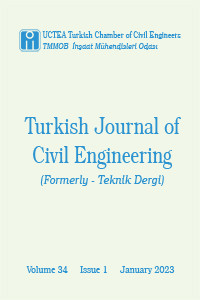Multi Agent System Based Risk Allocation Model for Public-Private-Partnership Type Projects (RAMP3)
Construction Industry, Construction Projects, Multi-Agent System (MAS), Public Private Partnership (PPP), Risk Management
Multi Agent System Based Risk Allocation Model for Public-Private-Partnership Type Projects (RAMP3)
Construction industry, construction projects, Multi-Agent System (MAS), Public Private Partnership (PPP), risk management,
___
- Ke, Y., Wang, S., Chan, A. P., Lam, P. T. I., Preferred Risk Allocation in China’s Public–Private Partnership (PPP) Projects, International Journal of Project Management, 28(5), 482–492, 2010.
- Hwang, B. G., Zhao, X., Gay, M. J.S., Public Private Partnership Projects in Singapore: Factors, Critical Risks and Preferred Risk Allocation from the Perspective of Contractor, International Journal of Project Management, 31(3), 424-433, 2013.
- Gross, M. E., Aligning Public-Private Partnership Contracts with Public Objectives for Transportation Infrastructure, Doctoral Thesis, Virginia Polytechnic Institute and State University, 2010.
- Yun-na, W. U., Xin-liang, H. U., Ling-shuang, X. U., Ze-zhong, L., Research on Risk Allocation of Public-Private Partnership Projects Based on Rough Set Theory, Communications in Information Science and Management Engineering, 2(7), 15-20, 2012.
- Marques, R. C., Berg, S., Risks, Contracts, and Private-Sector Participation in Infrastructure, Journal of Construction Engineering and Management, 137(11), 925-932, 2011.
- Thomas, A. V., Kalidindi, S. N., Ananthanarayanan, K., Risk Perception Analysis of BOT Road Project Participants in India, Construction Management and Economics, 21(4), 393–407, 2003.
- Lam, K. C., Wang, D., Lee, T. K. P., Tsang, Y. T., Modelling Risk Allocation Decision in Construction Contracts, International Journal of Project Management, 25(5), 485–493, 2000.
- Ren, Z., Anumba, C. J., Multi-Agent Systems in Construction–State of The Art and Prospects, Automation in Construction, 13(3), 421-434, 2004.
- Zhu, L., Zhao, X., Chua, D. K. H. Agent-Based Debt Terms’ Bargaining Model to Improve Negotiation Inefficiency in PPP Projects. Journal of Computing in Civil Engineering, 30(6), 04016014, 2016.
- Ke, Y., Wang, S., Chan, A., Cheung, E., Research Trends of PPP in Construction Journal, Journal of Construction Engineering and Management, 135(10), 1076–1086, 2009.
- Chengshuang, S., Guochang, Risk Management Framework of Multi-agent System for Construction Projects. Journal of Northeast Forestry University, 1-5, 2006.
- Li, B., Ren, Z., Bayesian Technique Framework for Allocating Demand Risk Between The Public and Private Sector in PPP Projects, 6th International Conference on Service Systems and Service Management, China, 2009.
- Karakas, K., Dikmen, I., Birgonul, M.T., Multiagent System to Simulate Risk-Allocation and Cost-Sharing Processes in Construction Projects, Journal of Computing in Civil Engineering, 27(3), 307-319, 2013.
- Taillandier, F., Taillandier, P., Tepeli, E., Breysse, D., Mehdizadeh, R., Khartabil, F., A Multi-Agent Model to Manage Risks in Construction Project (SMACC). Automation in Construction, 58, 1-18, 2015.
- Karakaş, K., Development of A Multi Agent System for Negotiation of Cost Overrun in International Construction Projects, Master of Science Thesis, Middle East Technical University, 2010.
- Dikmen, İ., Birgönül, M. T., Tanyer, A. M., Alparslan, F. N., Uluslararası İnşaat Projeleri İçin Çok Aracılı Bir Risk Modelleme Platformunun Geliştirilmesi, TÜBİTAK Project Report, Project No: 107M334, 2010.
- Dağkıran, G., A Multi Agent Risk Analysis and Sharing Platform for International Construction Projects Doctoral Thesis, Middle East Technical University, 2015.
- Python, https://www.python.org/ 29 July 2019.
- Prechelt, L. An empirical Comparison of C, C++, Java, Perl, Python, Rexx And Tcl. IEEE Computer, 33(10), 23-29, 2000.
- Sycara, K., Dai, T. Agent Reasoning in Negotiation. In: Kilgour D., Eden C. (eds) Handbook of Group Decision and Negotiation. Advances in Group Decision and Negotiation, vol 4. Springer, Dordrecht, 2010.
- Ren, Z., Anumba, C. J., Ugwu, O. O., Negotiation in a Multi-Agent System for Construction Claims Negotiation, Applied Artificial Intelligence, 16(5), 359-394, 2002.
- Ren, Z., Anumba, C. J., Ugwu, O. O., The Development of a Multi-Agent System for Construction Claims Negotiation, Advances in Engineering Software, 34(11), 683-696, 2003a.
- Ren, Z., Anumba, C. J., Ugwu, O. O., Multiagent System for Construction Claims Negotiatio, Journal of Computing in Civil Engineering, 17(3), 80-188, 2003b.
- Jennings, N. R., Faratin, P., Lomuscio, A. R., Parsons, S., Sierra, C., Wooldridge, M., Automated Negotiation: Prospects, Methods and Challenges, International Journal of Group Decision and Negotiation, 10(2), 199–215, 2001.
- Fidan, G., Dikmen, I., Birgonul, M. T., Using Multi Agent Systems in Construction Claim Negotiation, International Conference on Computing in Civil and Building Engineering and XVII Workshop on Intelligent Computing in Engineering, Nottingham-UK, 2010.
- Young, O.R., Bargaining: Formal Theories of Negotiation. University of Illinois Press, Urbana, 1975.
- Ren, Z., Anumba, C.J., Ugwu, O. O., Construction Claims Management: Towards an Agent‐Based Approach, Engineering Construction and Architectural Management, 8(3), 185-197, 2001.
- Rosenschein, J. S., Zlotkin, G., Rules of Encounter: Designing Conventions for Automated Negotiation Among Computers, MIT Press, Cambridge, MA, 1994.
- Aladağ, H.. Multi-Agent Risk Allocation Model for Build-Operate-Transfer (BOT) Type Transportation Projects, Doctoral Dissertation, Yildiz Technical University, 2016.
- ISSN: 2822-6836
- Yayın Aralığı: 6
- Başlangıç: 1990
- Yayıncı: TMMOB İnşaat Mühendisleri Odası
The Effect of Hydrated Lime Mixing Forms and Ratios on Performance in Asphalt Pavements
Celaleddin Ensar ŞENGÜL, Dündar AYYILDIZ, Erol İSKENDER, Atakan AKSOY
Ömer YÜKSEK, Tuğçe ANILAN, Fatih SAKA, Emrah ORGUN
The High Temperature Performance Evaluation of Polymer/Nanocomposite Modified Asphalt Cement
Mustafa ALAS, Ali ALBRKA, Hüseyin GÖKÇEKUŞ
Critical Inclination of Failure Surface and Seismic Active Earth Thrust for a Broken Slope Backfill
Determination of Finite Element Modelling Errors for Box Culverts Using Field Load Tests
Experimental Study of Hydrodynamic Pressures Acting on a Submerged Gate
Sochheat SMOK, Mehmet Anıl KIZILASLAN, Adnan KÜRÜMÜŞ, Ender DEMİREL
Evaluation of Stripping Problem in Terms of Additive Types and Ratios in Asphalt Pavements
Celaleddin Ensar ŞENGÜL, Atakan AKSOY, Erol İSKENDER
Sliding and Rollover on Highways - Subtleties to Note
An Investigation on Force Modification Factors in Cold-Formed Steel Structures
